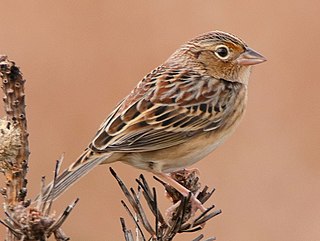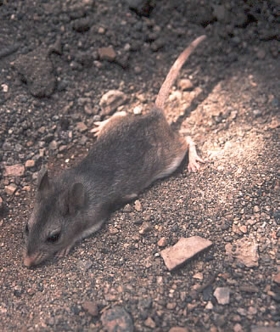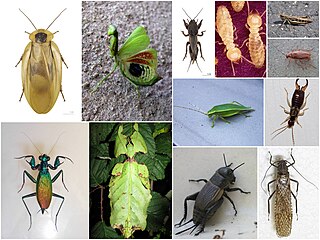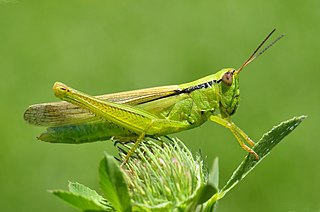
Orthoptera is an order of insects that comprises the grasshoppers, locusts, and crickets, including closely related insects, such as the bush crickets or katydids and wētā. The order is subdivided into two suborders: Caelifera – grasshoppers, locusts, and close relatives; and Ensifera – crickets and close relatives.

Locusts are various species of short-horned grasshoppers in the family Acrididae that have a swarming phase. These insects are usually solitary, but under certain circumstances they become more abundant and change their behaviour and habits, becoming gregarious. No taxonomic distinction is made between locust and grasshopper species; the basis for the definition is whether a species forms swarms under intermittently suitable conditions; this has evolved independently in multiple lineages, comprising at least 18 genera in 5 different acridid subfamilies.

The grasshopper sparrow is a small New World sparrow. It belongs to the genus Ammodramus, which contains three species that inhabit grasslands and prairies. Grasshopper sparrows are sometimes found in crop fields and they will readily colonize reclaimed grassland. In the core of their range, grasshopper sparrows are dependent upon large areas of grassland where they avoid trees and shrubs. They seek out heterogenous patches of prairie that contain clumps of dead grass or other vegetation where they conceal their nest, and also contain barer ground where they forage for insects, spiders, and seeds. Grasshopper sparrows are unusual among New World sparrows in that they sing two distinct song types, the prevalence of which varies with nesting cycle. The primary male song, a high trill preceded by a stereotyped series of short chips, is reminiscent of the sounds of grasshoppers and is the origin of this species' name. Like some other birds of the central North American grasslands, this species also moves around a lot, not only via annual migrations, but individuals frequently disperse between breeding attempts or breeding seasons. Grasshopper sparrows are in steep decline across their range, even in the core of the breeding distribution in the tallgrass prairies of the central Great Plains. The Florida grasshopper sparrow is highly endangered.

Grasshoppers are a group of insects belonging to the suborder Caelifera. They are among what is possibly the most ancient living group of chewing herbivorous insects, dating back to the early Triassic around 250 million years ago.

The Acrididae, or short-horned grasshoppers, are the predominant family of grasshoppers, comprising some 10,000 of the 11,000 species of the entire suborder Caelifera. The Acrididae are best known because all locusts are of the Acrididae. The subfamily Oedipodinae is sometimes classified as a distinct family Oedipodidae in the superfamily Acridoidea. Acrididae grasshoppers are characterized by relatively short and stout antennae, and tympana on the side of the first abdominal segment.

The dusky grouse is a species of forest-dwelling grouse native to the Rocky Mountains in North America. It is closely related to the sooty grouse, and the two were previously considered a single species, the blue grouse.
The Hagenbach-Bischoff quota is a formula used in some voting systems based on proportional representation (PR). It is used in some elections held under the largest remainder method of party-list proportional representation as well as in a variant of the D'Hondt method known as the Hagenbach-Bischoff system. The Hagenbach-Bischoff quota is named for its inventor, Swiss professor of physics and mathematics Eduard Hagenbach-Bischoff (1833–1910).

The Caelifera are a suborder of orthopteran insects. They include the grasshoppers and grasshopper-like insects, as well as other superfamilies classified with them: the ground-hoppers (Tetrigoidea) and pygmy mole crickets (Tridactyloidea). The latter should not be confused with the mole crickets (Gryllotalpidae), which belong to the other Orthopteran sub-order Ensifera.

The southern grasshopper mouse or scorpion mouse is a species of predatory rodent in the family Cricetidae, native to Mexico and the states of Arizona, California, Nevada, New Mexico, and Utah in the United States. Notable for its resistance to venom, it routinely preys on the highly venomous Arizona bark scorpion.
Jacob Johann Hagenbach was a Swiss entomologist.

Hagenbach is a commune in the Haut-Rhin department in Alsace in north-eastern France.

Apterygida media is a species of European earwig, known as the short-winged earwig or hop-garden earwig.
Stictoleptura erythroptera is a species of longhorn beetle in the Lepturinae subfamily. It was described by Jacob Johann Hagenbach in 1822 and can be found in Central and Western Europe,. The species can also be found in Eastern European countries like Bulgaria and Romania. It can also be found in Anatolia, the Caucasus and Iran.

Stictoleptura is a genus of longhorn beetle in the family Cerambycidae.

The cohort Polyneoptera is a proposed taxonomic ranking for the Orthoptera and all other Neopteran insects believed to be more closely related to Orthoptera than to any other insect orders. These winged insects, now in the Paraneoptera, were formerly grouped as the Hemimetabola or Exopterygota on the grounds that they have no metamorphosis, the wings gradually developing externally throughout the nymphal stages.

Roeseliana is a genus of bush cricket or katydid in the subfamily Tettigoniinae. Species in this genus were placed at various times in the genera Metrioptera and Bicolorana, until Roeseliana was restored in 2011.

Apterygida is a genus of insects belonging to the family Forficulidae.

Mecostethus is a genus of grasshoppers belonging to the family Acrididae. The species of this genus are found in Europe, Central Russia and Japan.















